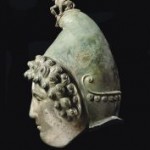Last May, a man armed with a metal detector stumbled on something almost magical in a farmer’s field in the Eden Valley of northwestern England. Buried under the earth were 74 metal fragments, some large, some small, but all clearly part of a Roman helmet. And not just any Roman helmet.
When the conservators at Christie’s in London had finished restoring it for an October 7th auction, Roman experts gasped. It was an exceedingly rare cavalry-sports helmet, a work of incredible beauty and great historical importance. Only officers of the highest rank or the best horsemanship were permitted to wear such helmets during sporting competitions. “Its face mask is both extremely finely wrought and chillingly striking,” noted Ralph Jackson, a curator at the British Museum, in a formal report. “It is a find of the greatest national (and, indeed, international) significance.”
Have you noticed anything wrong yet about this story?
 Let me give you a hint. How many archaeological finds described as being of the greatest national significance end up being listed on docket of an auction house? In Britain, I’m sorry to report, this happens quite a lot.
Let me give you a hint. How many archaeological finds described as being of the greatest national significance end up being listed on docket of an auction house? In Britain, I’m sorry to report, this happens quite a lot.
The British are great lovers of history, and they seem to have a special weakness for the Roman period. But the fellows who go out and find important Roman antiquities with metal detectors are often allowed to keep, sell or do whatever they like with the objects. As long as the artifacts don’t fit the very narrow legal definition of “treasure” in Britain–essentially objects that contain at least ten percent gold or silver and coins that date back more than 300 years old–British detectorists and landowners are entitled to sell them off to the highest bidder.
This is exactly what has happened to the Roman helmet. Forged from a copper alloy, it fails abysmally to meet Britain’s peculiar definition of treasure. So Christie’s is getting ready to auction it off: it expects a final bid somewhere between $315,000 and $470,000.
But there’s some good news here. The Tullie House Museum and Art Gallery in Carlisle, England, desperately wants to buy the helmet. So it has launched an urgent public appeal, asking concerned private citizens and companies to donate money so it can buy the helmet at auction. Over the past few days, nearly $40,000 has flowed in. People have dashed off cheques and concerned kids have given the museum their pocket money.
Ordinary people clearly recognize the importance of putting the helmet in a place where everyone can see it and sigh at its heart-breaking beauty. Why, oh why, can’t British legislators see that they need to do much, much more to protect their national treasures?
If anyone feels inclined to chip in a few bucks to help the Tullie House Museum and Art Gallery buy this treasure, you can find out how to do it here.
Photo courtesy of Christie’s.
I remember this striking mask. Especially as I know the area quite well. But, I am utterly shocked that this could be auctioned off instead of straight into a museum. Surely there must be somebody with influence in the government who is an antiquities fan?
Or could someone issue some kind of grant to go towards the bid?
Hi Rosie: Good to hear from you. I suspect that Tullie House Museum is calling in all the favors (and grants!) it possibly can. I’m hoping that some big corporation in the area will ultimately come through with a whopping donation to supplement the kids’ piggybanks.
What about one of the giant computer software gaming companies? There are quite a few games involving Romans. I’m sure they would love to claim to have saved this from obscurity…sorry…burbling.
That’s a brilliant idea. I’ll email the folks at Tullie House and suggest that. Thanks, Rosie.
H
More on the campaign to raise funds for the Roman helmet. Now a wealthy businessman has gotten into the act.
http://www.mandh-online.com/news/content/1330/success_in_roman_helmet_appeal